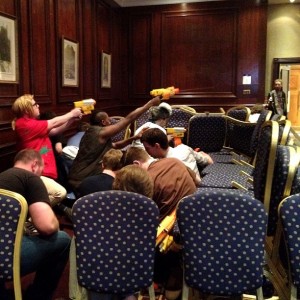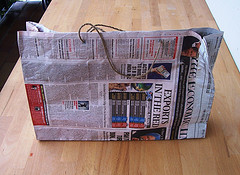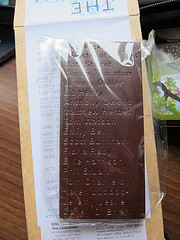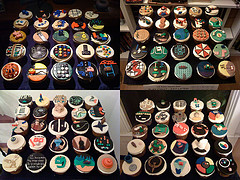 At the weekend Grant and I were invited to give a NERF panel at Kitacon. We started out thinking we’d talk about story in Zombie LARP again, as the crowd there are mostly unaware of what we do and are pretty into their storytelling, retelling and reimagining, from what we know. But when we realised we had a whole hour and a room to ourselves, we wanted to do something a little more interactive.
At the weekend Grant and I were invited to give a NERF panel at Kitacon. We started out thinking we’d talk about story in Zombie LARP again, as the crowd there are mostly unaware of what we do and are pretty into their storytelling, retelling and reimagining, from what we know. But when we realised we had a whole hour and a room to ourselves, we wanted to do something a little more interactive.
These days Zombie is a pretty massive affair, with 130 or so players at each event and more different NERF guns than you can shake a stick at. Way back when we started, though, it consisted of about four of us running around each other’s tiny student digs waving two NERF Mavericks and a Buzz Bee Double Shot, and dying messily in kitchens while disapproving flatmates tried to make dinner.
The process of making the game was, in itself, playful. Fun. It’s fun to run around with NERF guns and pretend to be zombies, but it’s also fun to turn that into a game with rules, like we all did when we were young kids. Making a thing you can play with your mates is its own sort of play.
So, we thought, what if we turned that into a panel? 20 minutes to make a game, with everyone in the room taking part; 20 minutes to play, and then some time to clean up and debrief and work out how to make it better?
We put together a set of questions to act as a game machine – a series of decisions to help a group of people get from zero to minimum viable game in as little time as possible, then iterate quickly between short rounds of play. We stuck with NERF guns as a basic mechanic, because they provide an easy seed for ideas, and because we find their “toy” status makes adults more likely to forget they’re adults and get into playing in the real world. We tested the system with my nieces and nephews while on holiday and ended up with Teatowel Panic, a team-based capture-the-flag-style game with wandering monsters, which we thought was a pretty good sign. The players also developed an unexpected extra mechanic when my dad started wandering around picking up ammo and then giving it to the teams at random.
The folks at Kitacon were brilliant and got what we were trying to do very quickly. I think it helped that we were in a place where normal rules of behaviour were at least partially suspended, with people who were quite happy to play for the sake of playing. We ended up with a game tentatively titled “Make the Geneva Convention Cry” in which players had to get a bomb into each other’s team bases and the best way to win would be to kill as many medics as possible. After round 1 we introduced a couple of new mechanics, and the second one went well enough that we left it as it was for the third game. Team Laser Explosion won the first two, but Team Monkey Pirate were the last ones left alive in the third.
We’re going to do it again, I hope – possibly at Gamecamp as we had such fun with Zombie there last year, and possibly other places. I hope – and I’m pretty sure – we’ll end up with something completely different every time.




